An appreciated citizen of Pest, the watchmaker Ferenc Sorndorfer, built the house at 13 Váci Street and 15 Régiposta Street in the 5th District, in 1804–1805, which is the oldest building on Váci Street. According to the first Zaiger Index created after Turkish times to clarify land relations and systematise tax matters, the land was still empty after the expulsion of the Turks. However, in the property tax census of 1696, we already find a one-room house in the area that belonged to János Hafner.
Ferenc Sorndorfer got the land in 1802. The name of the watchmaker is known for several reasons: on the one hand, he leased the right to clean the street from the capital; In 1796, he was among the 100 elected citizens, and for nearly twenty years he owned the funeral cars in Pest, which were rented from him by the funeral directors. According to the latest research, the design of the early classicist building can be attributed to Mihály Pollack, and it was certainly the first three-storey residential building in Pest.
In 1807, he opened his art shop on the ground floor of the Sorndorfer House, which was also the first art shop in Pest. Joseph Schreyvogel and Joseph Riedl, the two Viennese merchants, operated the store for four years and then moved into the building of the nearby Pest City German Theatre, which was behind today's Vigadó and was a busier location. Károly Lichtl from Sopron bought the shop in 1822 and moved back from the German theatre to the Sorndorfer House. There was no trade sign above Károly Lichtl's shop, only a sign in German indicating the offer. According to it, the shop had copper engravings, paintings, lithographs, maps, sheet music, plaster casts, but also musical instruments available.
.png)
Antal Alter's fashion house on a contemporary graphic (Source: oszk.hu)
The owner, Sorndorfer, died in 1813, and his daughter Anna Sorndorfer (Ferencné Steinbach) became the heir. Her husband was a city councillor and city chief clerk.
In 1823, Károly Lichtl published an advertisement in Hazai’s Külföldi Tudósítások about the offer of the pictures for sale, from here we know what could be bought in his shop: “The well-captured images of Emperor and King Francis I and his wife, Her Majesty; our beloved Palatine Joseph, Archduke and primate of our country, Sándor Rudnay and the immortal Péter Pázmány together with other great Hungarians […] which communion or institute would like to acquire these objects, should come take a visit and look at them."
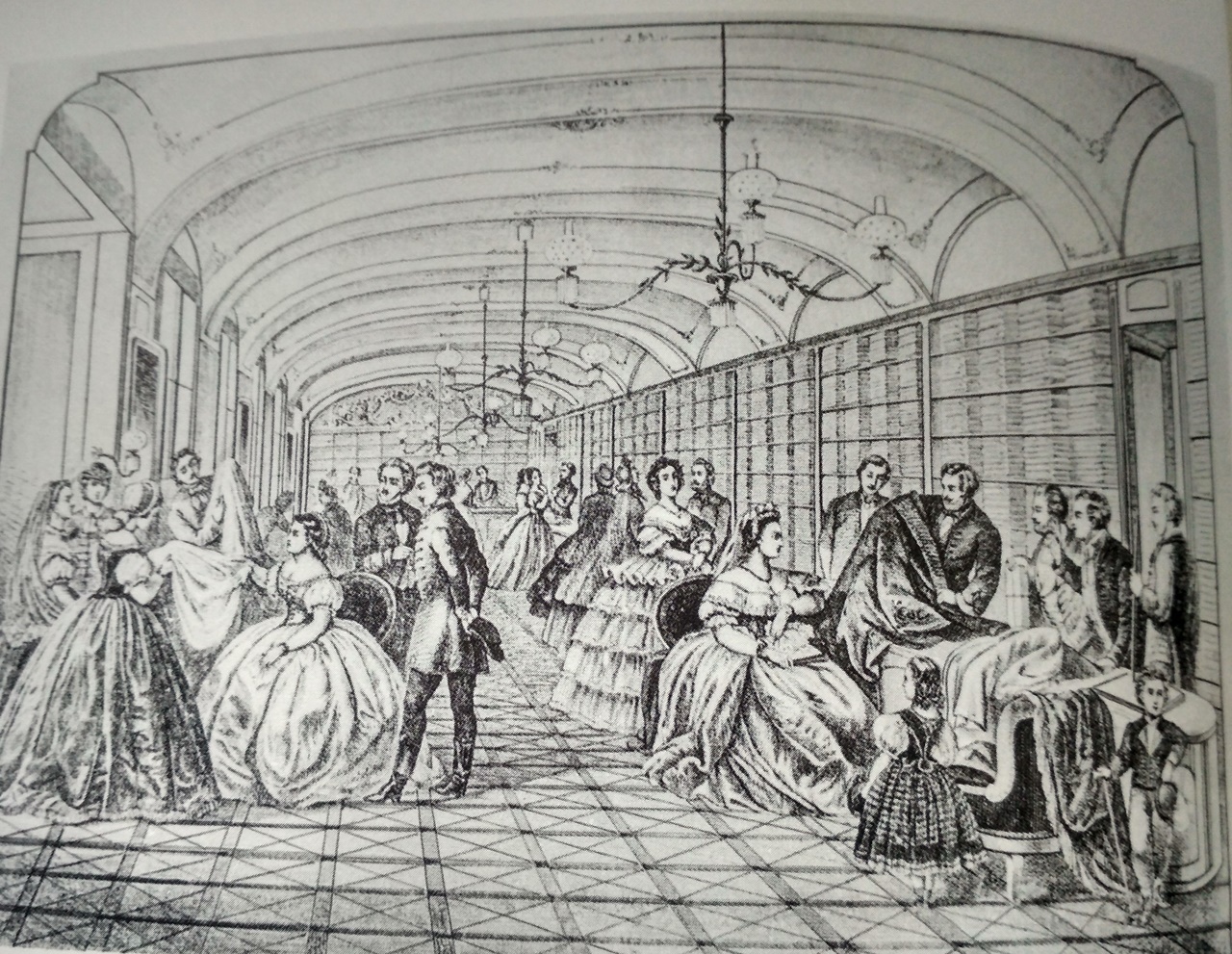
The interior of the Alter and Kiss fashion store operating in the house in the Bach era (Source: oszk.hu)
The business was closed by Lichtl two years later, after which several tenants took turns. The cloth-trade of the contemporary Pester and Murmann merchants was notable. A wide variety of items were sold, "in the largest quantities for general and officer's uniforms and Hungarian gala uniforms." After them, the ground floor housed the shop of Antal Alter's fabric store dedicated to the Archduchess Sophie. The coat of arms of the shop featured Archduchess Sophie in a white satin underdress, in a green barge velvet dress embroidered with gold - we can find out from the Regélő's 1836 description of the otherwise life-size coat of arms. The Archduchess wore a garland of pearls around her neck, a pearl bracelet on her arm, and an embroidered veil on her head. The picture was painted by Johann Mayer from Vienna.
In 1857, Hölgyfutár praised the business: “Who walked on Váci Street, this small boulevard in Pest in the past few days, is impossible not to have stopped in a place where the most poetic colours and beautiful fabrics compete silently to surpass each other in the light of gas. We are thinking of the hall of our very first fashion retailer, Antal Alter, where this time an extraordinary exhibition of gala clothes was organised. […] The exhibition was surprising, and the ladies present did not know what to stare more: the masterful, beautiful designs of the fabrics, or the excellent arrangement, in the harmony of which the eye could delight almost as much as in an artistically painted large landscape”.
.jpg)
The original gate of the house from Régiposta Street (Photo: Balázs Both/pestbuda.hu)
After Antal Alter returned to Vienna, in 1858 his nephew Eduárd Alter and Kornél Kiss took over the fashion store, which then operated as Alter and Kiss Fashion House. The company has not only become the first fashion retailer in Pest in these years, but it has also been famous in Europe. Elegant belongings were also made for the royal family. Due to the successful operation, they worked in two rooms at the same time: in the Steinbach House and in the Szentkirályi House opposite, in 11B Váci Street.
At that time, they were already making men's clothes. In the 2020 Step by Step series of the Hungarian National Museum, those interested could follow the restoration of a wedding dress, which was made in 1867 at the Alter and Kiss Fashion House. Based on the information card, it was included in the textile collection of the Hungarian National Museum in 1989, at a purchase price of approximately 30,000 HUF. The base fabric of the hand-sewn, white, sparsely woven linen-knitted cotton dress was adorned with black printing patterned with bouquets of flowers. It was coloured with blue, burgundy, yellow, purple and green embroidered floral appliqués and red velvet ribbon. The fashion house was closed in 1882. The famous tenant of the house was Kálmán Mikszáth and his wife, Ilona Mauks, in 1883–1884. They rented an apartment on the first floor, which was homely furnished. His wife also brought here her husband’s furniture and the legacy left over from her mother, a small rosy “Alt-Wien” coffee set she had dropped as a child but was an important memory for her.
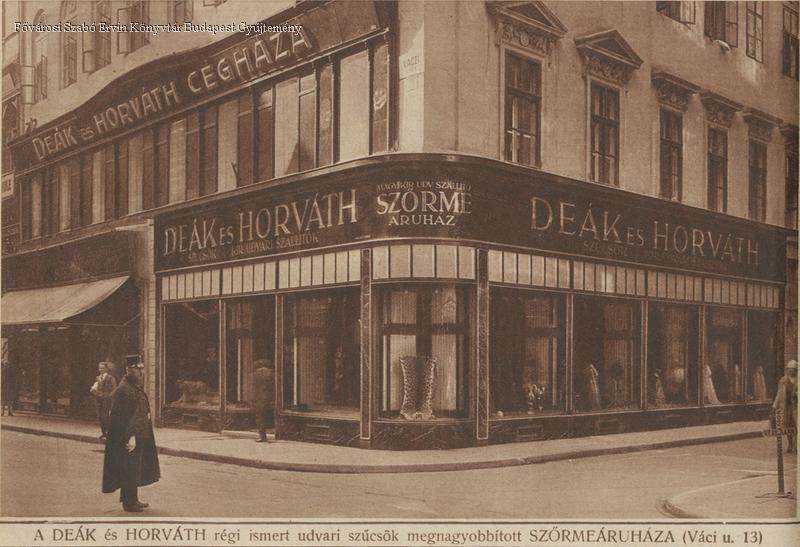
The Deák and Horváth Fur Store in 1928 (Source: FSZEK Budapest Collection)
According to his wife's recollections, he liked to live in the house on Váci Street, and it is also clear from her records that the street was still very quiet at that time, and the artist was able to work calmly. It was here that Kálmán Mikszáth wrote his work entitled 'Mór Jókai or The Boy from Komárom, who Conquered The World', and he edited his short book 'The Little Gentry and The People'. Dr. Endre Takács, chief physician, director of the Erzsébet Hospital and Polyclinic, pianist József Wurm, architect and restorer Kálmán Lux (his main work was the castle reconstruction of Esztergom between 1934 and 1938), and his brother, builder József Lux, also lived in the house.
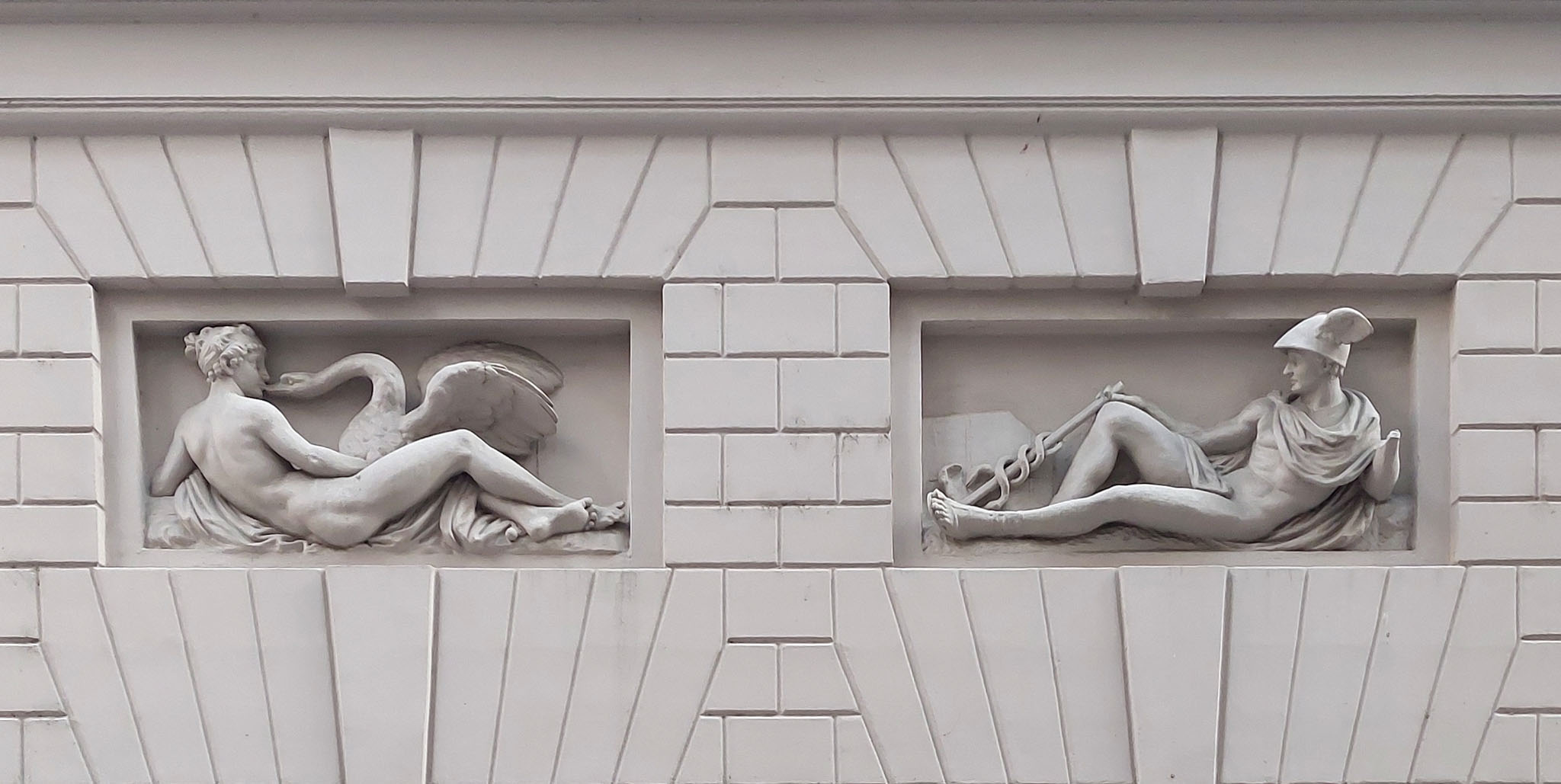
Relief of Leda and Hermes (Photo: Balázs Both/ pestbuda.hu)
The fur trade founded by János Deák and József Horváth in 1817 operated within the walls from 1888 to 1945. At that time, they were also the owners, and several alterations were made to the house.
The building was originally filled with artwork during its construction. The figural reliefs, medallion-holding puttos, eagles, eagle-headed, lion-shaped animals are still visible between the first-floor consoles. The bronze, lion-headed wings of the semicircular, keystone gate are original. Above the openings, windows and doors on the ground floor, the walls were decorated with 17 mythological reliefs. Today, 4 of them can be seen on the Régiposta Street side.
The one closer to Váci Street depicts Leda. The second depicts Hermes in his winged hat with his wand wrapped around snakes. The relief towards the sides of the gate shows Dionysus with vines in the background. In the fourth relief, Terpsychore, the daughter of Zeus and Mnemesh appears with a rattle drum in her hand.
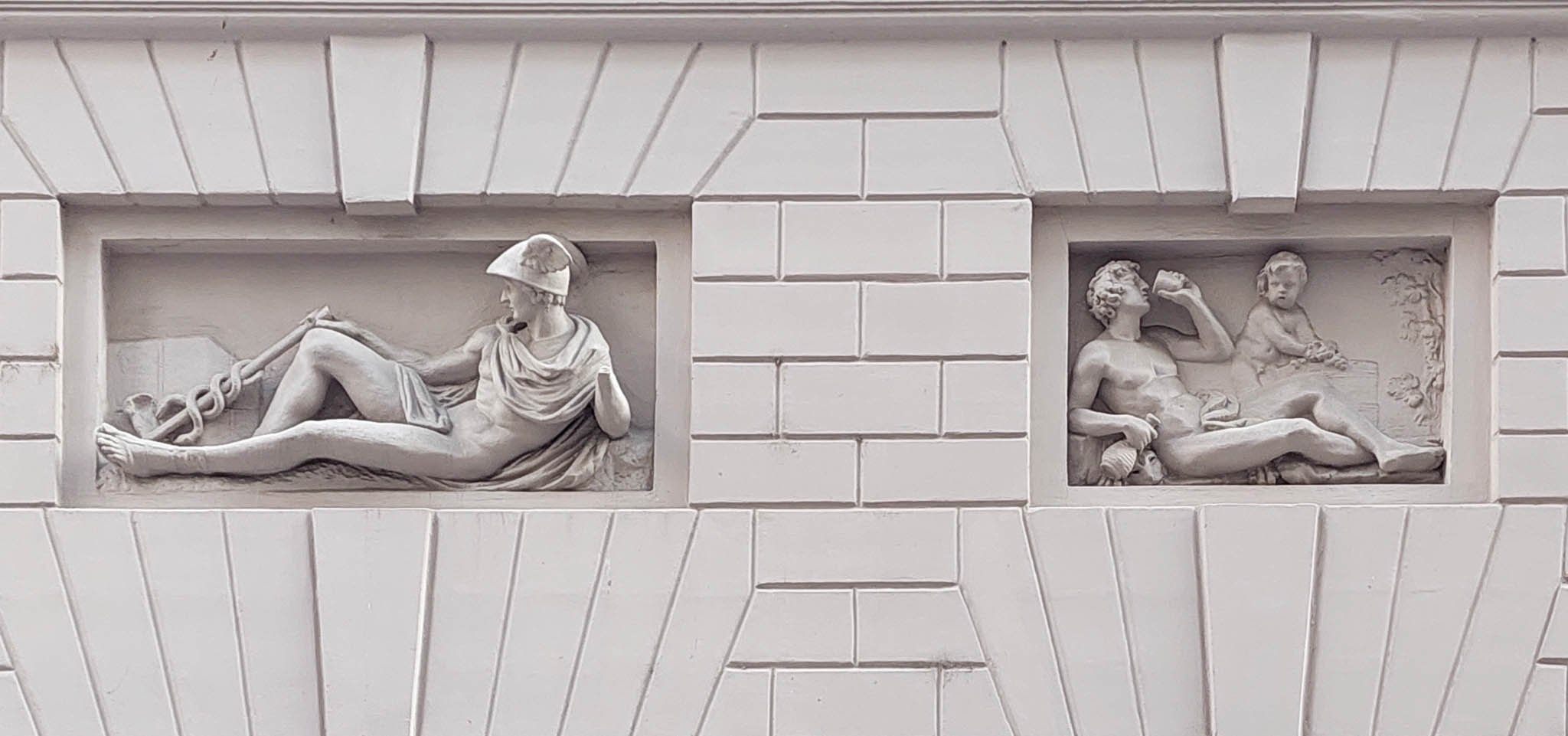
Dionysus and Terpsychore (Photo: Balázs Both/ pestbuda.hu)
The relief of Leda and Hermes was dismantled by the former owner of the house in the 1920s, while the other two works, Dionysus and Terpsychore (according to some sources, Aphrodite) remained in place. According to research, these were also removed in 1955 to make a copy of them. However, the original relief of Dionysus and Terpsychore was destroyed during the work. The two missing pieces were later re-carved based on a photograph. During the renovation of the building in 1963–1964, the four reliefs were restored to their original location.
Mutilation also hit the house. In 1936–1937, a house designed by Lajos Kozma and Vilmos Dénes was built on the plot at 13 Régisposta Street. During the construction of the house, a two-window section of the Régiposta Street front of the Schorndorfer House was demolished to attach the vacated plot to the new building. So instead of the nine windows on the Régiposta Street facade, there used to be eleven windows.
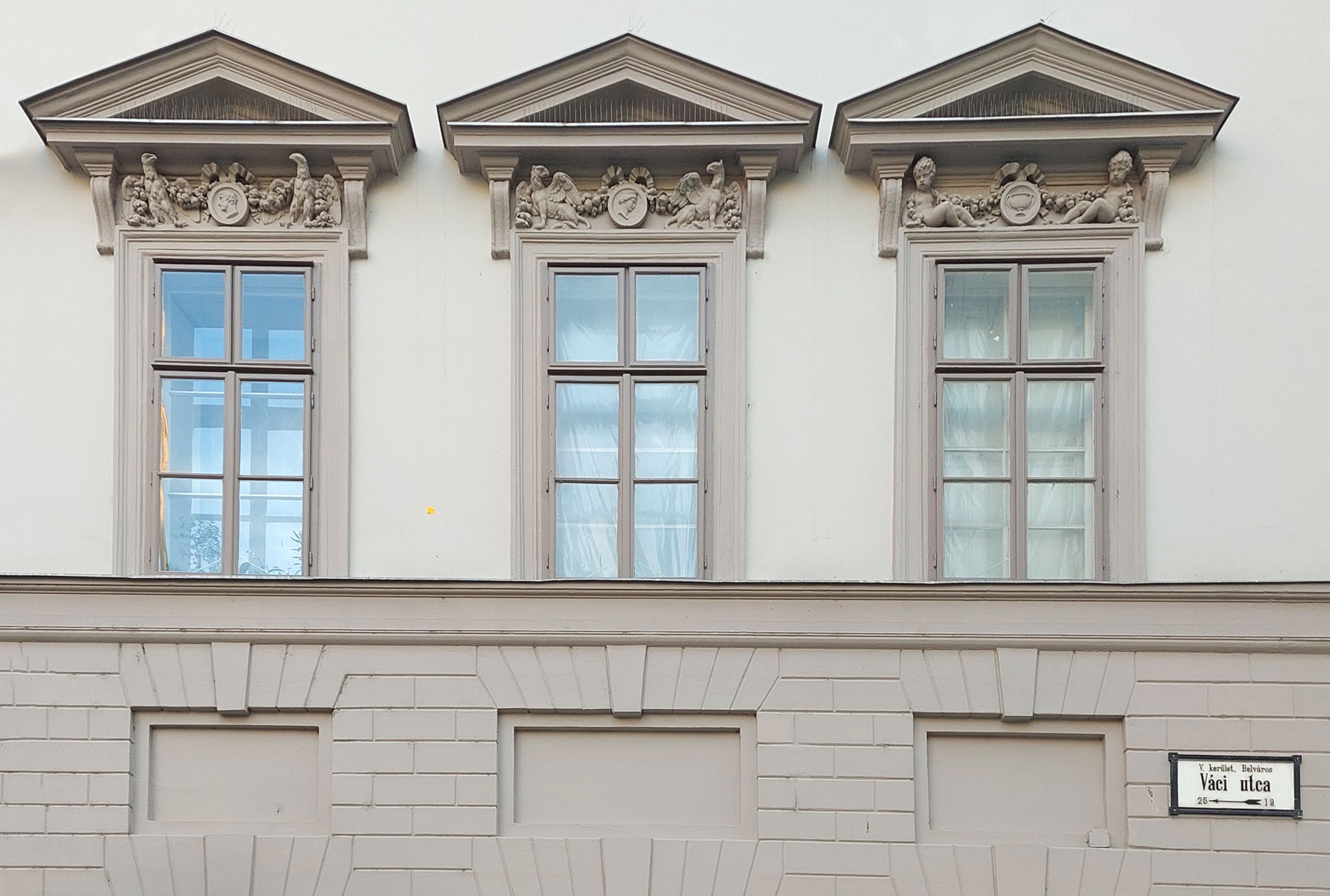
The house from Váci Street (Photo: Balázs Both/ pestbuda.hu)
The building was severely damaged during World War II. Between 1963 and 1964, it was partially renovated according to the plans of Gyuláné Lászlóczky (the reliefs were replaced at that time), who was the architect of several monument restorations in the 1960s, for example in the Buda Castle District. Between 1973 and 1974, based on the research of István Bibó and the surviving photos and drawings, the building was restored according to the plans of András Fehér. Retaining its original function today, it houses shops on the ground floor and apartments on the upper floors.
Cover photo: The oldest residential building on the street is at 13 Váci Street (Photo: Balázs Both/ pestbuda.hu)




































Hozzászólások
Log in or register to comment!
Login Registration